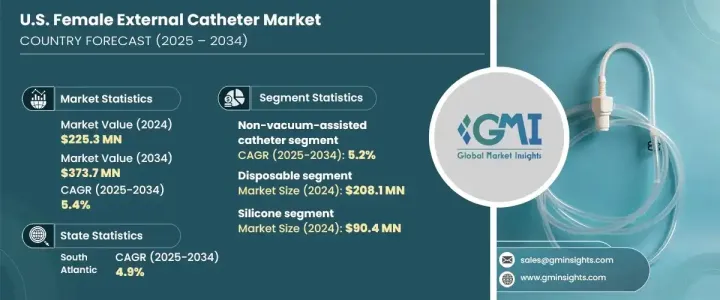PUBLISHER: Global Market Insights Inc. | PRODUCT CODE: 1684200

PUBLISHER: Global Market Insights Inc. | PRODUCT CODE: 1684200
U.S. Female External Catheter Market Opportunity, Growth Drivers, Industry Trend Analysis, and Forecast 2025 - 2034
U.S. Female External Catheter Market, valued at USD 225.3 million in 2024, is projected to expand at a CAGR of 5.4% from 2025 to 2034. This robust growth is driven by advancements in catheter technology, an increasingly aging population, and heightened awareness of urological health. Female external catheters, designed to provide a non-invasive and comfortable solution for urinary incontinence, are becoming integral to both clinical and home healthcare environments.

Innovations in product design and functionality have significantly improved user experience, making these devices more practical, discreet, and hygienic. As healthcare preferences shift toward convenience and patient independence, the market continues to witness strong adoption rates. Additionally, the growing focus on addressing urological issues among the elderly population and individuals with mobility challenges has further propelled demand for these solutions.
| Market Scope | |
|---|---|
| Start Year | 2024 |
| Forecast Year | 2025-2034 |
| Start Value | $225.3 Million |
| Forecast Value | $373.7 Million |
| CAGR | 5.4% |
The rising trend of home healthcare plays a pivotal role in boosting the adoption of female external catheters. With more patients managing their medical needs in the privacy of their homes, demand for user-friendly, single-use, and maintenance-free products has surged. These catheters align seamlessly with the growing preference for convenient and dignified care options, particularly among those seeking non-invasive solutions. Their discreet nature and ease of application make them an attractive choice for individuals and caregivers alike, further solidifying their position in the healthcare landscape.
The market is segmented by product type into disposable and reusable catheters. Disposable female external catheters generated USD 208.1 million in revenue in 2024, dominating the segment. Their popularity stems from the convenience they offer, as they eliminate the need for cleaning and maintenance. Designed for single use, these products are especially appealing to patients seeking straightforward and hassle-free management of urinary incontinence. As preferences increasingly shift toward non-invasive, comfortable, and hygienic options, disposable catheters are anticipated to maintain their strong market position.
Based on catheter type, the market is categorized into non-vacuum-assisted and vacuum-assisted devices. Non-vacuum-assisted catheters accounted for USD 197.1 million in 2024 and are set to grow at a CAGR of 5.2% over the forecast period. Their ease of use and comfort are significant factors driving their widespread adoption. Employing adhesive or adhesive-free mechanisms, these catheters eliminate the complexities of suction or vacuum systems, offering users a simpler, more comfortable experience.
In the South Atlantic region, the female external catheter market was valued at USD 47.6 million in 2024, with a projected CAGR of 4.9% between 2025 and 2034. States like Florida, characterized by a significant aging population, drive regional demand for urinary incontinence solutions. Aging is a key risk factor for urinary incontinence, creating a growing need for effective, comfortable, and non-invasive management products such as female external catheters.
Table of Contents
Chapter 1 Methodology and Scope
- 1.1 Market scope and definitions
- 1.2 Research design
- 1.2.1 Research approach
- 1.2.2 Data collection methods
- 1.3 Base estimates and calculations
- 1.3.1 Base year calculation
- 1.3.2 Key trends for market estimation
- 1.4 Forecast model
- 1.5 Primary research and validation
- 1.5.1 Primary sources
- 1.5.2 Data mining sources
Chapter 2 Executive Summary
- 2.1 Industry 3600 synopsis
Chapter 3 Industry Insights
- 3.1 Industry ecosystem analysis
- 3.2 Industry impact forces
- 3.2.1 Growth drivers
- 3.2.1.1 Increasing prevalence of urinary incontinence
- 3.2.1.2 Growing awareness about female incontinence management
- 3.2.1.3 Technological advancements
- 3.2.1.4 Rise in chronic conditions
- 3.2.2 Industry pitfalls and challenges
- 3.2.2.1 Risk of infections and skin irritation
- 3.2.2.2 High cost associated with advanced catheter
- 3.2.1 Growth drivers
- 3.3 Growth potential analysis
- 3.4 Regulatory landscape
- 3.5 Reimbursement scenario
- 3.6 Technology landscape
- 3.7 Pricing analysis
- 3.8 Porter's analysis
- 3.9 PESTEL analysis
- 3.10 Gap analysis
- 3.11 Future market trends
Chapter 4 Competitive Landscape, 2024
- 4.1 Introduction
- 4.2 Company matrix analysis
- 4.3 Company market share analysis
- 4.4 Competitive analysis of major market players
- 4.5 Competitive positioning matrix
- 4.6 Strategy dashboard
Chapter 5 Market Estimates and Forecast, By Product Type, 2021 - 2034 ($ Mn)
- 5.1 Key trends
- 5.2 Disposable
- 5.3 Reusable
Chapter 6 Market Estimates and Forecast, By Catheter Type, 2021 - 2034 ($ Mn)
- 6.1 Key trends
- 6.2 Non-vacuum-assisted catheter
- 6.3 Vacuum-assisted catheter
Chapter 7 Market Estimates and Forecast, By Material, 2021 - 2034 ($ Mn)
- 7.1 Key trends
- 7.2 Silicone
- 7.3 Latex
- 7.4 PVC (polyvinyl chloride)
- 7.5 Other materials
Chapter 8 Market Estimates and Forecast, By Application, 2021 - 2034 ($ Mn)
- 8.1 Key trends
- 8.2 Urinary incontinence
- 8.3 Urinary retention
- 8.4 Post-surgical recovery
- 8.5 Neurological disorders
- 8.6 Other applications
Chapter 9 Market Estimates and Forecast, By End Use, 2021 - 2034 ($ Mn)
- 9.1 Key trends
- 9.2 Hospitals
- 9.3 Ambulatory surgical centers
- 9.4 Specialty clinics
- 9.5 Other end users
Chapter 10 Market Estimates and Forecast, By Zone, 2021 - 2034 ($ Mn)
- 10.1 Key trends
- 10.2 East North Central
- 10.3 West South Central
- 10.4 South Atlantic
- 10.5 Northeast
- 10.6 East South Central
- 10.7 West North Central
- 10.8 Pacific Central
- 10.9 Mountain States
Chapter 11 Company Profiles
- 11.1 BD (Becton, Dickinson and Company)
- 11.2 BOEHRINGER
- 11.3 Cardinal Health
- 11.4 Coloplast
- 11.5 consure MEDICAL
- 11.6 convatec
- 11.7 CooperSurgical
- 11.8 Hollister
- 11.9 Stryker
- 11.10 tilla care




